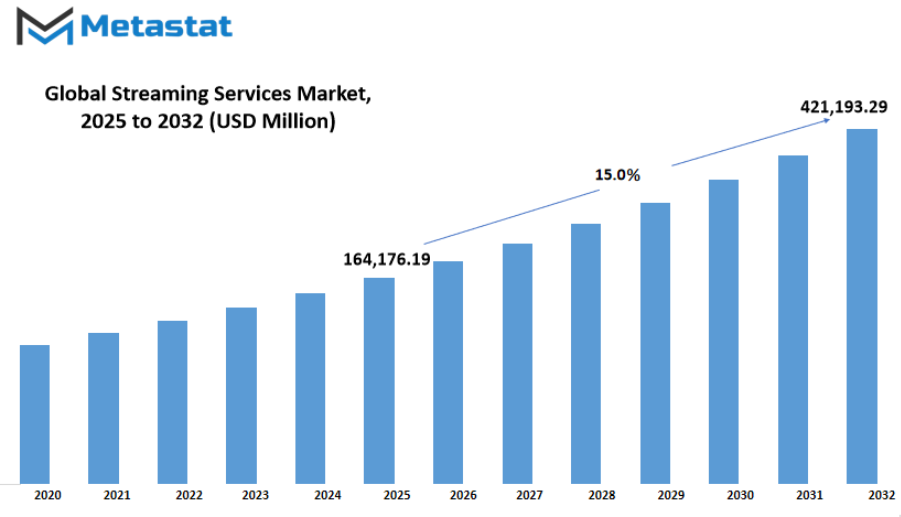MARKET OVERVIEW
The global streaming services market will redefine the way humans consume entertainment across the world, reaching homes, devices, and work processes with a beat that will feel intimate and instant. In the business of delivering video over the internet, this space will extend much further than anyone currently envisions. It will appear in living rooms, mobile screens on busy trains, and even digital boards at workplaces, engaging individuals into stories, performance, and information as though next door. What will distinguish this segment is the capacity to dissolve customary limits.
Individuals will be expecting fresh forms from interactive stories to live events on demand that will combine entertainment, news, and social engagement. Platforms will be testing formats that encourage engagement. Some will share viewing choices with algorithmic recommendations, while others will add their own voice to the content experience by voting, responding, or even shaping plot lines. This type of personalization will be like a conversation, not a broadcast. At the core of this space, platforms will form new types of partnerships. Movie studios, solo artists, news outlets, creators in rural areas there will be a way for all to bring diverse voices into one room.
A producer from a tiny nation will broadcast straight to viewers on the other side of the world. A local broadcaster will deliver to city dwellers who will then translate stories across languages. The platform will enable such matchmaking in ways that were previously impossible. Infrastructure will adapt in tandem. Networks, data centers, and content-delivery networks will scale to accommodate unpredictable bursts of demand sports games, breaking news, exclusive premiers while delivering consistent quality. Technical teams will engineer systems that distribute bandwidth dynamically, so millions can watch a premiere at the same time without delays, regardless of location. In most of the world, access will broaden, as equipment becomes more affordable and connection speeds increase. Monetization strategies will change, as well. Viewers will select flexible subscriptions, micro-payments for individual episodes, or ad-supported viewing that is dynamic and adjusts in real time based on what they're watching. Creators will select monetization streams that align with their viewers' wants, and platforms will provide frictionless flow between free and paid status. That flexibility will be second nature, removing the friction between wanting to watch and being able to pay. Cultural influence will be more apparent. Tapes from around the world will find an audience with little lag time; people will feel for others over distances they've never seen. An evening performance at a festival in one nation will be watched elsewhere at the same moment, and a comment from another will generate wide discussion. Geography will disappear from content; sounds will be everywhere.
Over time, consumers will demand the sort of on-demand, immersive experiences that will have been futuristic at one point. The international market for streaming services will not be a fixed business, but a ever-evolving, viewer-focused tapestry of entertainment, information, and social engagement. Those who will define it will pay close attention to what people will need next, creating platforms that will feel dynamic, interactive, and profoundly human.
Global streaming services market is estimated to reach $421,193.29 Million by 2032; growing at a CAGR of 15.0% from 2025 to 2032.

GROWTH FACTORS
The global streaming services market is transforming entertainment consumption, driven by technological and consumer shifts at a constantly accelerating rate. As viewers increasingly turn to on-demand content, the platforms for streaming have transformed from being a substitute for television to being the dominant form of entertainment for the majority of households around the world. This swelling demand for convenience and personalized viewing will not abate in the near future, and streaming will hence become part of everyday life very soon.
One of the strongest driving forces for such a revolution is increased use of smartphones and increasing availability of high-speed internet. With better connectivity and affordable hardware, individuals can view their favorite TV shows and movies on demand at any place and at any time. This easy access not only boosts the level of user engagement but also creates opportunities for platforms to build new subscriptions from other parts of the globe. Streaming comes second nature to younger generations, and the trend will continue to drive growth for the next several years. But the market for global streaming services has huge challenges that can invariably impact its growth rate.
The first major problem is the extremely expensive purchase of content rights and production. Due to demanding audiences that require original and high-quality content, platforms have no option but to pay a lot to buy rights and produce original content. The increased costs tend to stretch profitability, particularly for smaller or newer companies struggling to compete with larger leviathans. Another growing issue is subscription fatigue. With the number of platforms now entering the fray, the customers are already exhausted with the number of subscriptions they have to hold on to in order to keep up with their favorite programming. This competition further makes it tougher for individual services to witness steady subscriber growth. As good as such situations are, the future ahead for the global streaming services market is bright with extremely high opportunities. One such opportunity space is that of emerging markets, in which internet penetration is growing at a very rapid rate.
With digital networks spreading in parts of Asia, Africa, and Latin America, more and more people will have access to streaming media. These markets contain vast reservoirs of latent users, and sites capable of responding to localized tastes and price models will enjoy massive growth potential. Future innovation will be key to shaping the direction of the market. Future innovations in artificial intelligence and data analytics will allow platforms to provide more personalized content, increasing user satisfaction and loyalty. Furthermore, alliances with telecommunications providers and technology companies should also bring new avenues for consumers to access streaming services at a discounted rate.
Though competition and overheads will still be an issue, growth opportunities and innovations are an indication of a very healthy and thriving future for the world streaming services industry.
MARKET SEGMENTATION
By Type
The global streaming services market will continue to grow rapidly in the coming years as technology becomes more advanced and accessible. The way people consume digital content has shifted completely, with streaming becoming the preferred choice for entertainment, learning, and even communication. Faster internet speeds, affordable subscription plans, and a wide range of content libraries have created an environment where streaming is not just a trend but a standard part of everyday life.
By type, the global streaming services market is segmented into video streaming, music streaming, game streaming, and others. Video streaming will likely remain the largest segment as platforms keep expanding their offerings, producing original shows, movies, and even live events to attract users. High-quality visuals, personalized recommendations, and the convenience of accessing content anytime will keep video streaming at the center of this market. In the future, video platforms will also integrate more interactive features, such as live chats and virtual experiences, to keep users engaged.
Music streaming will also continue to grow, driven by user-friendly apps, curated playlists, and affordable subscription models. With improvements in audio quality and features like offline downloads, listeners will have even more reasons to stay loyal to their preferred platforms. As artificial intelligence develops, music streaming platforms will likely deliver highly personalized experiences, suggesting songs and artists that match users’ moods and preferences in real time.
Game streaming is another area that will see rapid growth. As cloud gaming technology becomes more reliable, users will be able to play high-quality games without the need for expensive consoles or high-end devices. This accessibility will encourage more players to join and will likely lead to a rise in competitive gaming and interactive online communities. With faster internet connections and better streaming platforms, gaming will become a shared and more social experience.
The “others” category in the global streaming services market includes areas such as live events, e-learning, and podcasts. These services will keep gaining attention as people look for convenient and flexible ways to learn, work, and stay informed. Virtual classrooms, live business events, and streaming-based education platforms will continue to improve, offering users more interactive and engaging content.
Looking ahead, the global streaming services market will benefit from the integration of new technologies like artificial intelligence, augmented reality, and virtual reality. These tools will create richer, more personalized experiences that will keep audiences engaged across all types of streaming platforms. As competition grows, companies will focus on innovation and user satisfaction to secure their place in this dynamic digital landscape.
By Platform
The global streaming services market will continue to grow rapidly as technology becomes more advanced and internet access improves across the world. With more people relying on digital platforms for entertainment, education, and even work-related content, streaming has become a key part of daily life. This growth is driven by the constant demand for quick access to movies, shows, live events, and other types of content without the need for traditional broadcasting or physical media. In the coming years, the market will not only expand in size but also in the way it delivers content, offering more personalized and interactive experiences to users everywhere.
By platform, the market is divided into smartphones, laptops and desktops, smart TVs, tablets, and others. Smartphones will continue to hold the largest share because they are portable, convenient, and affordable for most users. People want to watch content anytime and anywhere, and mobile apps make this possible. Laptops and desktops will remain popular, especially for users who prefer larger screens and better controls for streaming. Smart TVs will keep growing in usage as they provide a seamless, high-quality viewing experience at home, often connected with other devices for smooth integration. Tablets, while less dominant, will still attract users who want a bigger screen than a smartphone without sacrificing portability. Other platforms, such as gaming consoles and VR devices, will slowly carve out their own space as technology and user preferences shift toward more immersive viewing options.
Looking toward the future, the global streaming services market will focus on better user experiences powered by artificial intelligence and data-driven recommendations. Content libraries will grow larger, but platforms will also work to suggest the most relevant shows or events to each user. As internet speeds get faster and more stable in many regions, high-quality streaming, including 4K and even 8K content, will become more common. Moreover, interactive streaming, where users can influence content or engage with live features, will shape the way audiences interact with platforms.
The market will also see stronger competition as new platforms enter and existing ones work to keep users engaged. Price adjustments, bundled services, and original content will play a major role in attracting and retaining subscribers. As technology evolves, streaming will not be limited to just entertainment but will expand into sectors like education, fitness, and live commerce, creating more opportunities for growth. The future of the global streaming services market will be shaped by convenience, quality, and innovation, ensuring that streaming continues to be a central part of how people connect with digital content worldwide.
By Content Type
The global streaming services market will continue to shape the way people consume content, transforming entertainment, education, and communication on a massive scale. Over the past decade, the market has grown rapidly, fueled by advances in internet connectivity, mobile technology, and the demand for flexible viewing options. As more users seek convenience and personalization, this market will expand even further, offering experiences that are more interactive and user-friendly than ever before.
Looking ahead, the global streaming services market will not only cater to entertainment but also reach into areas such as virtual learning, business communication, and interactive events. Faster internet speeds and the adoption of 5G technology will make high-quality streaming more accessible, even in regions that currently face connectivity challenges. This improvement will lead to a significant increase in subscriptions, as more people around the world gain access to smooth, uninterrupted streaming experiences.
By content type, the market is divided into live streaming and on-demand streaming, each meeting different user needs. Live streaming will gain more attention as viewers look for real-time connections. Sports, gaming, concerts, and even live talk sessions will continue to grow in popularity, providing audiences with experiences that feel immediate and personal. Platforms will likely enhance features such as real-time interaction, creating spaces where viewers can connect, comment, and share moments as they happen.
On the other hand, on-demand streaming will remain the dominant choice for users who want flexibility. With an ever-expanding library of shows, movies, educational content, and tutorials, viewers will have more control over what they watch and when they watch it. The growth of artificial intelligence in content recommendation will make this experience even more personalized, helping viewers discover content tailored to their interests without having to search extensively.
The global streaming services market will also see partnerships between technology providers, content creators, and advertisers to bring more innovative solutions. Enhanced analytics will allow platforms to understand user behavior better, leading to smarter strategies for content production and delivery. This shift will also benefit independent creators, giving them greater visibility and opportunities to reach global audiences without traditional barriers.
As technology advances, the competition within the global streaming services market will drive companies to focus on innovation and quality. Better user experiences, original content, and affordable subscription models will attract larger audiences. Over time, streaming will not just be an option but a primary way for people to stay entertained, informed, and connected, making the market an essential part of daily life across the world.
By Revenue Model
The global streaming services market has grown rapidly over the past decade and will continue to transform how people consume content in the future. With the rise of faster internet connections and the expansion of smart devices, streaming has become a normal part of daily life. As technology keeps advancing, more people around the world will gain easier access to these platforms, driving even higher levels of growth in the coming years. The demand for instant and flexible entertainment options will push companies to keep improving their platforms, creating a competitive space where innovation will be key.
By revenue model, the global streaming services market is divided into subscription-based, advertisement-based, transaction-based, and hybrid models. The subscription-based approach will remain a leading force as users prefer paying a fixed amount for unlimited access to content. This model provides platforms with steady income, which allows them to invest in better content libraries and exclusive shows or movies. Advertisement-based services will also see strong growth, particularly in regions where users may not be willing or able to pay for premium plans. These services allow free access but rely on targeted ads for revenue, making them appealing to a wide range of audiences.
Transaction-based models, where users pay for individual content without committing to a subscription, will still hold a place in the market. This model works well for those who prefer occasional viewing rather than ongoing memberships. Meanwhile, the hybrid approach will become increasingly popular because it combines elements of multiple models. For example, a platform might offer a low-cost subscription with occasional ads or a mix of free and premium content options, creating flexibility for different types of viewers.
Looking ahead, the global streaming services market will not only focus on content but also on user experience. Platforms will invest more in personalized recommendations powered by artificial intelligence, helping viewers find exactly what they want faster. Interactive and immersive technologies, such as virtual reality and live interactive features, will shape how users engage with content, making the experience more dynamic and personal. Additionally, the spread of 5G and even faster networks will improve streaming quality, reducing buffering and allowing for higher-resolution content anywhere in the world.
As competition grows, streaming platforms will also expand their global reach, tailoring content to fit local languages, cultures, and preferences. This will help companies strengthen their presence in emerging markets and create more opportunities for content creators worldwide. With these developments, the global streaming services market will continue to evolve, offering more choices, better experiences, and new ways for people to connect with the content they love.
|
Forecast Period |
2025-2032 |
|
Market Size in 2025 |
$164,176.19 million |
|
Market Size by 2032 |
$421,193.29 Million |
|
Growth Rate from 2025 to 2032 |
15.0% |
|
Base Year |
2024 |
|
Regions Covered |
North America, Europe, Asia-Pacific Green, South America, Middle East & Africa |
REGIONAL ANALYSIS
The global streaming services market is growing at an impressive pace and will continue to transform the way people consume digital content in the future. With the rise of high-speed internet and affordable smart devices, streaming has moved from being a luxury to an everyday activity. As technology continues to improve, more users are gaining access to on-demand video, audio, and live content, which will push the market to expand even faster in the coming years.
Based on geography, the global streaming services market is divided into North America, Europe, Asia-Pacific, South America, and the Middle East & Africa. North America, which includes the U.S., Canada, and Mexico, currently leads the market due to early adoption of technology, a high number of content creators, and strong digital infrastructure. The U.S., in particular, will remain a driving force in innovation as major platforms keep launching new features and personalized content options.
Europe, which consists of the UK, Germany, France, Italy, and the Rest of Europe, is also showing steady growth. Consumers in this region are increasingly shifting from traditional cable services to streaming platforms that offer flexibility and varied choices. With investments in localized content and language-specific programming, Europe will likely see a sharp increase in subscription rates and ad-supported platforms over the next few years.
Asia-Pacific, segmented into India, China, Japan, South Korea, and the Rest of Asia-Pacific, is the fastest-growing region in this market. Affordable internet, rising smartphone use, and a growing appetite for diverse content are driving rapid adoption. Countries like India and China are especially significant, as they have massive populations and growing middle classes eager for entertainment that fits their preferences.
In South America, which includes Brazil, Argentina, and the Rest of South America, the market is expanding as internet access improves. Brazil will likely lead this growth, supported by younger audiences who prefer mobile streaming and localized shows.
The Middle East & Africa, categorized into GCC Countries, Egypt, South Africa, and the Rest of the Middle East & Africa, is showing potential for significant development. While adoption rates are currently lower compared to other regions, increasing investments in infrastructure and growing demand for digital content will help this region catch up in the future.
As competition grows, platforms will need to focus on innovation, user-friendly experiences, and localized offerings to keep pace with consumer expectations. The global streaming services market will not just change how people access content, but also shape the future of entertainment worldwide.

COMPETITIVE PLAYERS
The global streaming services market will move beyond what we know now, and one can imagine how our favorite stories will come to us in new ways. For millions, Netflix, Amazon Prime Video, Hulu, Disney+, HBO Max, Apple TV+, YouTube TV, Peacock, Paramount+, Sling TV, fuboTV, Crunchyroll, Discovery+, DAZN, Rakuten Viki, BBC iPlayer, Tencent Video, iQIYI, Sony Crackle, Starz will still be familiar names, but they will not stay the same. They will grow and change, finding ways to reach us more personally. I picture a time when choosing what to watch will feel effortless, with platforms sensing what mood we are in or where we are, and offering just the right content even suggesting stories we didn’t know we needed.
In that future, these services will feel less separate and more woven into daily life. That show you start while cooking breakfast could follow you right into your living room when you sit down. A documentary you pause on your tablet might pick up on the big screen when you get home, with no need to search again. Streaming platforms will blend into our routines so naturally that we hardly notice them doing the heavy lifting. It’s easy to imagine them adapting to our tastes with more precision learning that you enjoy dramas with strong characters, or that you prefer short episodes when you travel. Recommendations will feel almost thoughtful, as if a friend arranged your next watch.
This shift will also invite more creators around the world to share stories. You might discover a gripping thriller from iQIYI or Tencent Video, then switch to a heartfelt series on Rakuten Viki or BBC iPlayer all with the same ease. That kind of access will widen what we think of as entertainment, bringing together stories from different places and voices. The global streaming services market of tomorrow will be about connection helping us find stories that move us, challenge us, or simply make us smile, no matter where they come from.
As these platforms evolve, the way we experience storytelling will change too. The future of watching is not just about what we choose, but how platforms learn, adapt, and bring stories to us, making our choices feel personal and effortless.
Streaming Services Market Key Segments:
By Type
- Video Streaming
- Music Streaming
- Game Streaming
- Others
By Platform
- Smartphones
- Laptops & Desktops
- Smart TVs
- Tablets
- Others
By Content Type
- Live Streaming
- On-Demand Streaming
By Revenue Model
- Subscription-Based
- Advertisement-Based
- Transaction-Based
- Hybrid
Key Global Streaming Services Industry Players
- Netflix
- Amazon Prime Video
- Hulu
- Disney+
- HBO Max
- Apple TV+
- YouTube TV
- Peacock
- Paramount+
- Sling TV
- fuboTV
- Crunchyroll
- Discovery+
- DAZN
- Rakuten Viki
- BBC iPlayer
- Tencent Video
- iQIYI
- Sony Crackle
- Starz
WHAT REPORT PROVIDES
- Full in-depth analysis of the parent Industry
- Important changes in market and its dynamics
- Segmentation details of the market
- Former, on-going, and projected market analysis in terms of volume and value
- Assessment of niche industry developments
- Market share analysis
- Key strategies of major players
- Emerging segments and regional growth potential








 US: +1 3023308252
US: +1 3023308252






